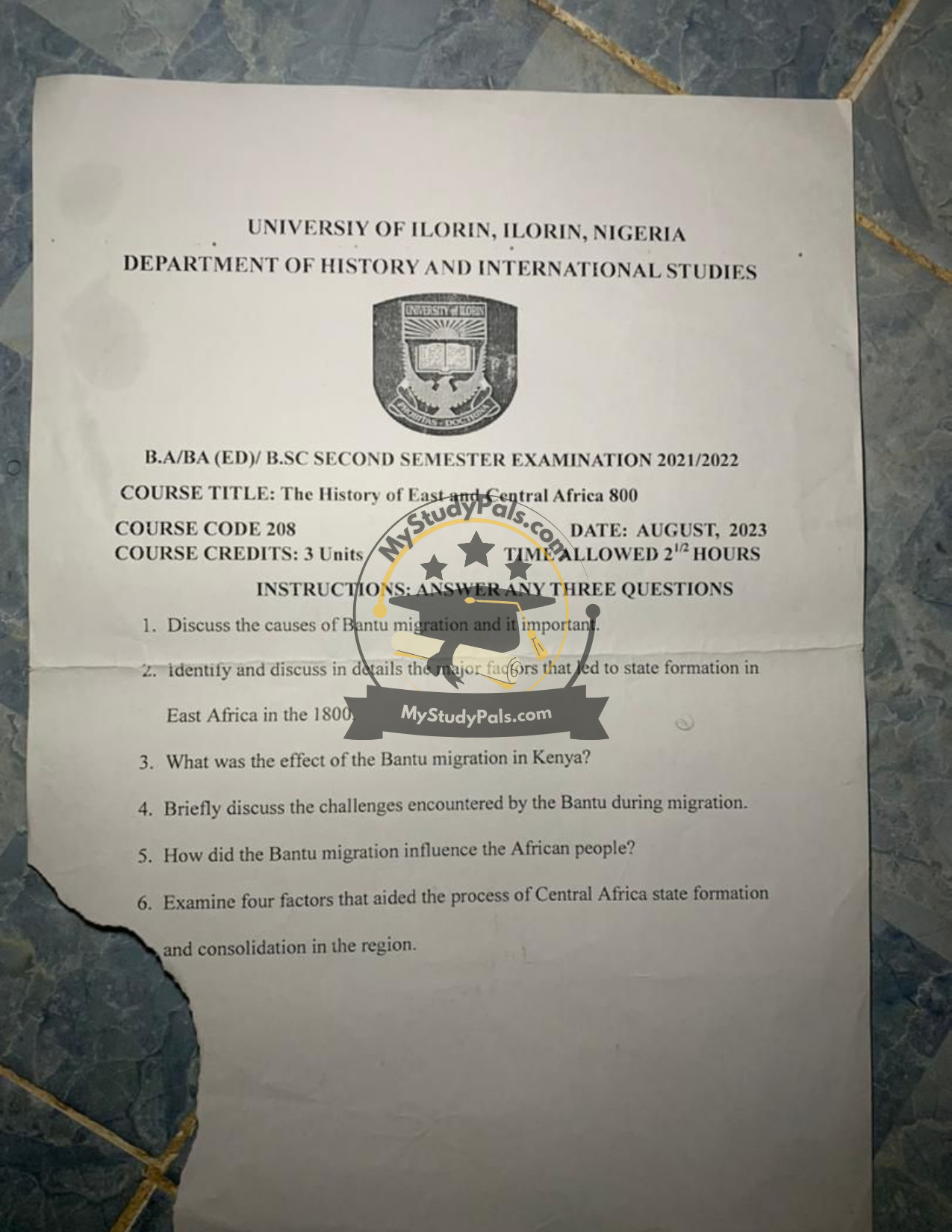ANWSER
—
Question 1: Discuss the causes of Bantu migration and its importance.
The Bantu migration, which began around 2000 BCE, was a significant movement of Bantu-speaking peoples across sub-Saharan Africa. The causes and importance of this migration are as follows:
Causes:
1. Population Pressure: Overpopulation in their original homeland (likely around modern-day Cameroon/Nigeria) led to the search for new land.
2. Climate Change: Droughts and environmental changes made agriculture difficult, prompting migration to more fertile regions.
3. Economic Factors: The Bantu were farmers and ironworkers, and they sought areas with better soil and resources for cultivation and metalworking.
4. Conflict and Warfare: Competition over land and resources with neighboring groups forced some Bantu communities to move.
5. Adventure and Exploration: Some migrations were driven by the desire to explore and settle new territories.
Importance:
1. Spread of Agriculture: The Bantu introduced advanced farming techniques and crops like yams and bananas.
2. Ironworking Technology: They spread iron smelting and tool-making, revolutionizing agriculture and warfare.
3. Cultural Diffusion: Their migration led to the spread of Bantu languages, traditions, and social structures across Africa.
4. State Formation: Their settlements contributed to the rise of organized kingdoms and states in East, Central, and Southern Africa.
—
Question 2: Identify and discuss in detail the major factors that led to state formation in East Africa in the 1800s.
State formation in East Africa during the 1800s was influenced by several key factors:
1. Trade Networks: The growth of long-distance trade (e.g., Swahili coast trade with Arabs and Europeans) led to wealth accumulation, enabling powerful leaders to establish centralized states (e.g., Buganda, Zanzibar Sultanate).
2. Agricultural Surplus: Fertile regions supported large populations, allowing surplus food production, which sustained armies and administrative systems.
3. Military Strength: Strong leaders used armies to conquer neighboring territories, forming larger political units (e.g., the rise of the Nyamwezi under Mirambo).
4. External Influences: Contact with Arab, European, and Indian traders introduced new political ideas, weapons, and administrative systems.
5. Leadership and Centralization: Charismatic rulers (e.g., Kabaka of Buganda) centralized power, created bureaucracies, and imposed taxation systems.
6. Cultural and Religious Unity: Shared languages (e.g., Swahili) and the spread of Islam helped unify diverse groups under single political entities.
—
Question 3: What was the effect of the Bantu migration in Kenya?
The Bantu migration had profound effects on Kenya:
1. Agricultural Development: Bantu introduced new crops (e.g., millet, sorghum) and farming techniques, transforming local economies.
2. Ironworking: They brought iron tools and weapons, improving farming efficiency and warfare capabilities.
3. Cultural Integration: Bantu languages (e.g., Kikuyu, Luhya) became dominant, blending with indigenous cultures.
4. Population Growth: Their settlements led to increased population density in fertile regions like the Kenyan highlands.
5. Social Organization: Bantu clan systems and centralized chieftaincies influenced local governance structures.
—
Question 4: Briefly discuss the challenges encountered by the Bantu during migration.
The Bantu faced several challenges:
1. Hostile Environments: Dense forests, deserts, and diseases (e.g., malaria) hindered movement.
2. Resistance from Indigenous Groups: Some communities (e.g., Khoisan in Southern Africa) resisted Bantu expansion.
3. Food Shortages: Migrating groups sometimes struggled to find arable land quickly.
4. Natural Barriers: Rivers (e.g., Congo, Zambezi) and mountains slowed progress.
5. Internal Conflicts: Disputes over leadership and resources arose within migrating groups.
—
Question 5: How did the Bantu migration influence the African people?
The Bantu migration influenced Africa in multiple ways:
1. Linguistic Impact: Bantu languages became widespread, forming the basis of over 500 modern languages.
2. Technological Advancements: Iron tools and farming methods boosted productivity.
3. Cultural Exchange: Bantu intermarried with locals, creating blended traditions (e.g., Swahili culture).
4. Political Systems: Their settlement patterns encouraged centralized kingdoms (e.g., Great Zimbabwe).
5. Demographic Shifts: The migration reshaped population distributions across sub-Saharan Africa.
—
Question 6: Examine four factors that aided the process of Central Africa state formation and consolidation in the region.
Four key factors include:
1. Trade: The trans-Saharan and Congo Basin trade networks provided wealth and resources for state-building (e.g., Kongo Kingdom).
2. Iron Technology: Advanced tools enabled efficient farming and military expansion.
3. Strong Leadership: Rulers (e.g., Manikongo of Kongo) centralized power and created administrative systems.
4. Geographical Advantages: Rivers (e.g., Congo) facilitated transport, communication, and territorial control.
—


